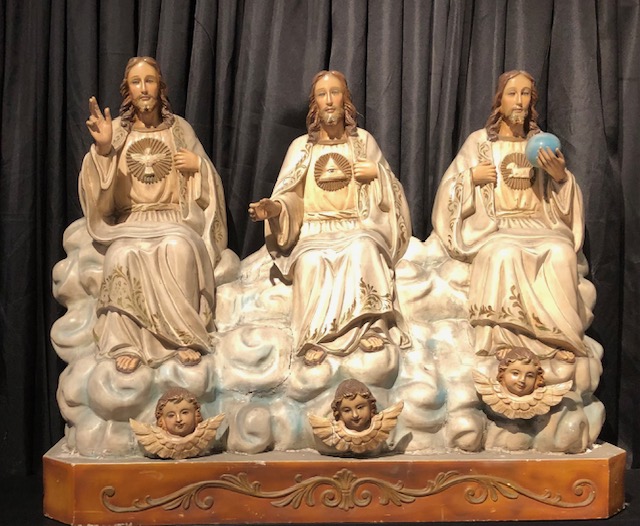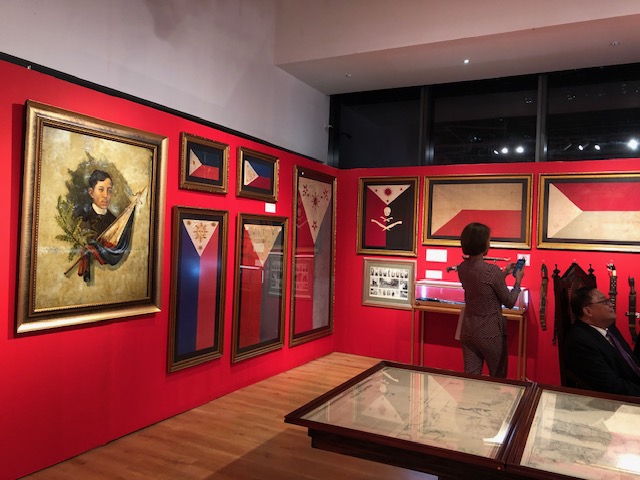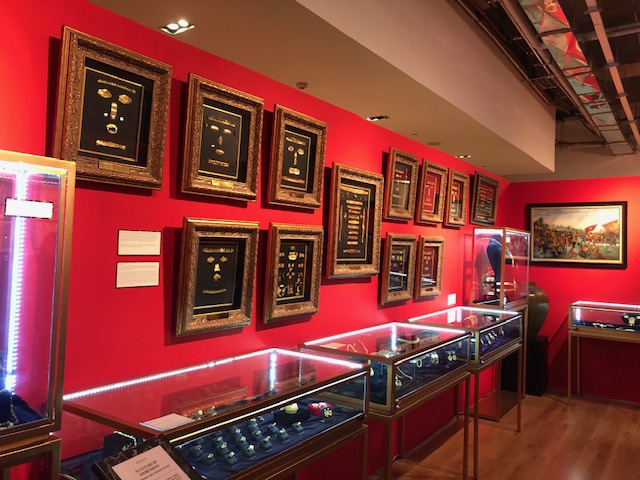WALA LANG
A remarkable couple, banker Edwin Bautista and academician Aileen B. Bautista, teamed up to form a unique collection of Philippine material heritage that the perceptive scholar and writer Florencio “Floy” Quintos declares “gives a deeper meaning and resonance to the narrative of an evolving nationhood.”
Indeed, an exhibition of the Bautista collection organized by Salcedo Auctions’ Ramon E.S. Lerma and Karen Lerma, illuminates how our nation was born out of numerous self-contained and often warring groups; how ancient belief systems survived with a new religion introduced or if you like, imposed, by colonial masters; how ancient artistry evolved with changing times; how traces of ancient weaponry and strategy were used to fight new enemies.
Quintos curated the exhibit. He selected about one-tenth of the objects in the Bautista collection and presented them to dramatically narrate the Filipino experience.

“Diyos Tres Personas”
Gallery One of the exhibit features early maps that show how inconsequential we were in European eyes 400 years ago. Geographers and cartographers like Ortelius, Coronelli, and Mercator knew India and China but the Philippines was just a jumble of unnamed, unrelated, and worthless islands. There was little gold and spices and it was only after the Spaniards made evangelization a mission and realized the potential of the Galleon Trade that a map was published in Amsterdam showing the major islands from and labeled “Insulae Philippinae.” Ateneo professor Leo Garcia calls this the Philippines’ birth certificate.
The maps show our progression from 1521 to 1898, bookended by “Insula Mathan” showing the encounter of Magellan and Lapulapu and a set of three large maps laid out on a long table with two facing chairs. It is a visual metaphor of the Treaty of Paris negotiated by Spaniards and Americans while Filipinos were on the sidelines watching with no seat at the table.

Jose Rizal Niño
Surrounding the Treaty of Paris table are Katipunero flags that saw action during the Revolution against Spain and flags of the First Philippine Republic under Emilio Aguinaldo during the Filipino-American War. These are souvenirs picked up on battlefields and brought home by the victorious American soldiers. They are echoes of distant battles that recall our brave ancestors who gave up their lives fighting under those very banners and, might we add, in the hope of the freedom and prosperity we now enjoy?
When diplomacy fails, hope turns to bullets, guns, and cannon. Bladed weapons are useful in close combat and for ceremonial purposes. In the collection are such deadly looking examples from the Philippine Revolution, the war with the US, the “Moro Wars” against both invaders, and internecine feuds among neighboring highland groups.

Banners captured by victorious American soldiers and the “Treaty of Paris” map.
There are armor of carabao horn and weapons of our brethren in Mindanao, the Visayas (mainly Panay), and the Cordilleras. The elaborate ones are clearly for ceremonial occasions but others would be suited for real fighting. More than the utilitarian machetes or bolos that artists depict with Andres Bonifacio shouting, Sugod, mga kapatid! those in the exhibit are notable for outstanding design, craftsmanship and material, as well as deadliness in use.
Gallery Two would delight actress Beauty Gonzalez whose pretty neck and ears were adorned with gold leaves that last saw service to seal eyes and mouths of perhaps a dozen high-status dearly departeds and fondly remembereds. (Beauty was accused of grave robbery.) Hanging on an exhibit wall is a row of framed gold cutouts that once graced the brows, eyes, nose, ears, and mouths of our elite dead to protect evil spirits from occupying the dead body. A similar object, the 14th to 15th century Oton Death Mask is a National Treasure. In glass cases are necklaces, bracelets and bangles, earrings, arm bands, rings, and other adornments, including a splendid belt, that accompanied our ancestors to the afterlife, found mainly in Butuan, Surigao, and Samar. Many extraordinary objects invoke the Garuda, a Buddhist and Hindu deity depicted as an eagle-like sun bird associated with the god Vishnu.

Pre-Hispanic gold, with framed gold death masks on the wall
The craftsmanship of pre-Hispanic goldsmiths is carried forward to Spanish Regime jewelry collected by Aileen Bautista. These are the tambourin, alfajor, escapulario, peineta, and other objects made with the granulation, filigree, and rose gold work of ancient times.
Gallery Three consists of religious objects of the Spanish Regime. These were once in churches and homes, including almost full-size processional images brought out for town fiestas, Semana Santa, and other special occasions. There are two large ivory crucifixes repatriated from Europe, large images once on church retables, an altar frontal and silver tabernacle, candlesticks and ramillete (simulated bouquets) assembled as in a church altar, a baptistry relieve supposedly from Tanay, Rizal, a Station of the Cross, paintings on canvas and on panel (known hereabouts as “icon”), including one that shows a processional image of Santa Ana with Iloilo’s Molo church in the background.
Gallery Four is in a half-concealed room entered through a narrow passage behind Part Three’s altar ensemble. There one discovers what Bautista calls our “secret spirituality,” a divine system of images, talismans, incantations, potions, attire, and ceremonies that protect one from harm, bring prosperity, love, power, devastate one’s enemies.
Bautista gave a running commentary to Arthaland’s Jimmie Gonzalez, ACCRA’s Francis Lim, and your columnist, highlighting the beliefs and practices underlying anting-anting (talismans) of metal, ivory, sacred woods, and vests with figures and prayers. He singled out an image of San Miguel modeled on the label of Ginebra San Miguel, a portable niche where the powers of an object are refreshed, an image “Jose Rizal Niño” venerated by Rizalistas—Rizal is usually depicted as a grown man but he was obviously once a boy, a large image of the Holy Trinity depicted as three adults, made by famous maker of Catholic images Maximo Vicente for the a Samahánthat venerates Diyos na Tres Personas.
Straddling Galleries Three and Four are images of the Holy Family and Catholic saints called mamarrachos or grotesqueries by priests. They could have been made by unskilled sculptors or by skilled sculptors departing from the ordinary. Priests refused to bless them but, in some places, images so dismissed are considered “more powerful.” A couple of images from Siquijor, beautiful ones to me, are described as being mamarracho.
The Bautistas and Salcedo Auctions took a great deal of effort and expense to mount the exhibit that rarely for Philippine visual arts exhibits also has a printed and fully illustrated catalogue ready on opening night. Pity there were just two by-invitation-only evenings and two the-public-may-enter days. This is the kind of thought-provoking, engaging, carefully curated, and marvelously designed exhibit that should be studied and admired at leisure and that should reach everyone.
Notes: The exhibit Private Art, Public Lives opened on Thursday, Aug. 31 and closed on Sunday, Sept. 3 at Salcedo Auctions at NEX Tower on Ayala Avenue. Edwin Bautista is president of Union Bank and Aileen Bautista is professor at De La Salle – College of St. Benilde and Asia Pacific College. Floy Quintos is professor at the University of the Philippines, playwright, and authority on mass communication and Philippine culture.